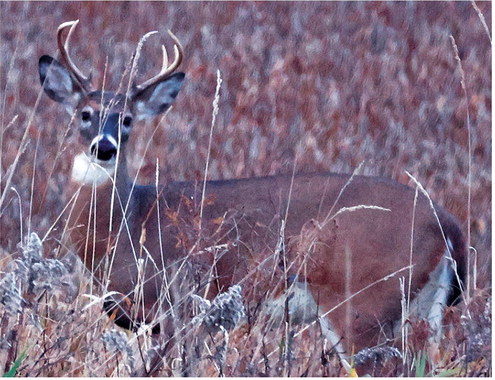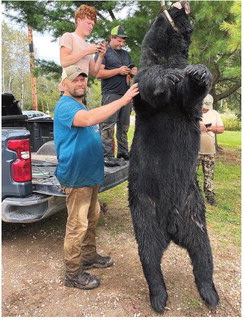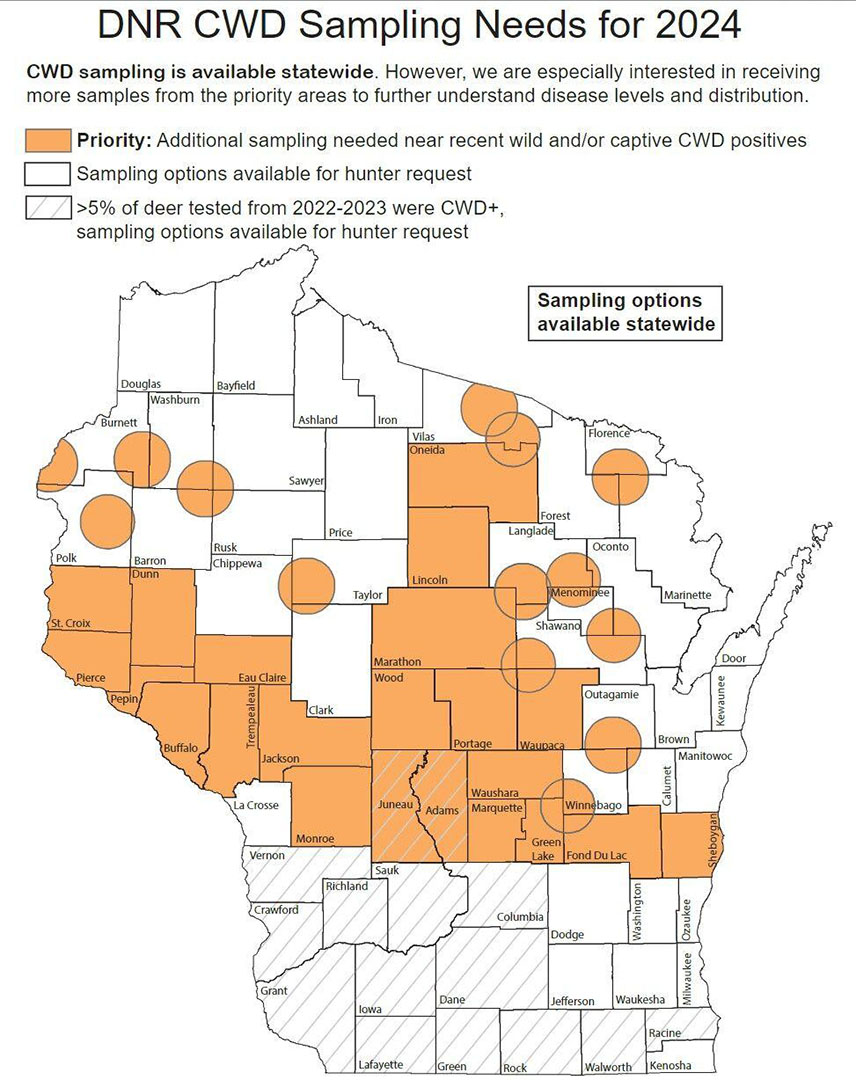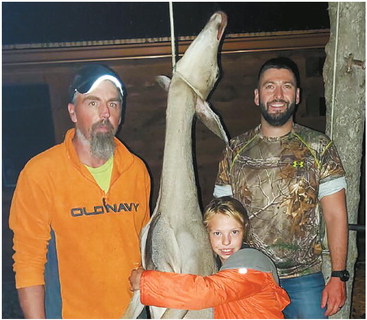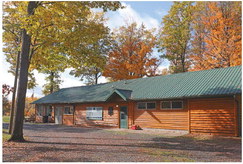Gun deer season outlook
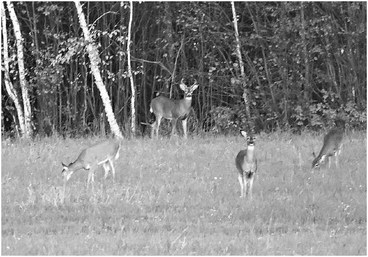

A buck hangs at the edge of a woodlot and watches a group of does and fawns just outside of Medford on a mid-October evening. Wisconsin’s nine-day gun deer hunt starts next weekend, running Nov. 18-26. The muzzleloader hunt Nov. 27-Dec. 6, the statewide antlerless hunt Dec. 7-10 and the archery/crossbow seasons that run through Jan. 7 are options for harvesting a late-fall deer.
By Matt Frey, The Star News
The flip of the calendar from October to November certainly is meaningful to most of Wisconsin’s white-tailed deer hunters.
For those who have not gotten their shot at a buck yet this fall with archery equipment or a crossbow, the early part of the month likely served as their best chances to bag a big one as the deer’s mating season, the rut, kicked into high gear.
Then, of course, there is the annual nine-day gun hunting season, which begins next Saturday, Nov. 18 and runs through Nov. 26 and will lure several hundred thousand Wisconsin hunters into the woods, fields and marshes at one point or another and reunite friends and family at time-honored hunting camps.
So far this fall, at least in the local four-county area of Taylor, Clark, Chippewa and Marathon counties, hunters were harvesting deer at a slower place through the end of October than they were in 2022. The numbers, as reported on the Department of Natural Resources’ harvest data website, did seem to spike upward in the last few days of October, likely signifying the rut –– and possibly higher hunter effort –– had kicked in.
Wisconsin DNR wildlife personnel expected deer populations to be strong and healthy for the most part coming into the fall. How strong the numbers are, of course, depends on the area and habitat you hunt. While the snowpack lingered into April, temperatures weren’t overly cold in that time, minimizing any winter effects on vulnerable deer. In the West Central District, which includes Clark, Chippewa and Marathon counties, the snow melted quickly and green-up was in full effect by May.
Taylor County is in the Northern Forest region, which can be more susceptible to winter severity, but the hardest-hit areas of the region were well north of the county.
“There is lots of food available this fall especially,” said Emma Hansen, the DNR’s wildlife biologist for Taylor and Rusk counties. “That, I think, helped them catch up from last winter. We had a long winter, but we didn’t have a lot of cold days. This year it was drawn-out but we didn’t have the cold. We had a winter severity index in Taylor County of 41 and that’s still in the mild category. There were pockets, and when you think of the Chequamegon-Nicolet National National Forest deep in the interior of the woods, there’s not as much food available in those settings so they might have been hit a little harder in areas like that. The dry spring might have been really good for little fawns to keep warm and grow. Now this fall that we have a lot of natural food on the landscape we have a completely healthy deer herd on the landscape for this year’s hunting season.”
Weather always plays a factor in how the harvest during a nine-day gun season compares to seasons past. One factor that could play into hunters’ favor is the Nov. 18 start, the second-earliest date possible under Wisconsin’s season format. That may increase the odds slightly for good weather on opening weekend and increase the odds that the rut won’t be completely over.
“We’ll be closer to the peak of the rut,” Hansen said. “Of course, gun deer season doesn’t really overlap with the peak. That’s usually the last week of October, early November, somewhere around there. But we definitely should see some trickling effects of that.”
Next year, due to leap year, the start date will revert back to the latest start date possible, Nov. 23.
After the nine-day hunt ends, hunting options include the muzzleloader season Nov. 27-Dec. 6, the statewide antlerlessonly hunt Dec. 7-10, holiday antlerless hunts Dec. 24-Jan. 1 in many deer management units, especially in the southern half of the state and the archery/crossbow season, which extends to Jan. 7, 2024 in most units. The bow season does go through Jan. 31 in some of the state’s most heavily-populated units.
Here is a forecast synopsis for the four-county Central Wisconsin News coverage area.
Taylor County
The 2023 deer hunt seems to be off to a slow start in Taylor County, but the hope is that the harvest will pick up in November with the rut hitting its peak and, hopefully, good weather for the early Nov. 18 start to the nine-day gun deer season.
“It’s been slow,” the county’s DNR wildlife biologist Emma Hansen said in an Oct. 26 interview. “So far this year we’ve had warm weather and it seems like on a lot of weekends we’ve had rain so that not only limits deer movement, but people aren’t out there either hunting. We’re definitely down. At this time of the year we’re a little lower than our five-year average for where we’re normally at this time of year.
“That can always change depending on the conditions during gun deer season,” she added. “We’ve been in situations in the past where it’s been pretty slow but you get those great opening days with a fresh blanket of snow, it’s 20-30 degrees out and that can really make an impact and shoot your harvests up above average. Really we’re still waiting to see how things shape up overall, just depending on how things look in the gun deer season.”
Through Oct. 30, crossbow hunters had registered 374 deer, including 202 bucks and 172 antlerless deer, while archery hunters had stuck an additional 155 with 68 of them being bucks and 87 being antlerless. At this point a year ago, crossbow hunters had registered 583 deer and archery hunters had bagged 263.
Harvest numbers aside, Hansen said the herd in the county should be healthy and deer numbers, in general, are strong.
As the southernmost county in the DNR’s Northern Forest region, there should have been little winter impact on the herd. There was some concern about the long winter when the county’s Deer Advisory Council met in May and reduced antlerless permit levels slightly. The 8,520 private land tags aren’t likely to sell out (3,250 remained as of Nov. 1), while the 595 public tags were gone within a matter of a few hours, as usual. As it turned it, the county’s winter severity index was only 41, almost entirely due to snow cover, which still fell in the mild category.
“One of the challenges is we have public land scattered throughout the county,” Hansen said. “The Managed Forest Law Open properties are also considered public land and those are scattered quite a bit within the private land. So it can be challenging trying to manage a deer herd when those private and public land tags are mixed in with each other. A fairly significant portion of the county is in the Chequamegon-Nicolet National Forest.
Those areas that are primarily forest, especially in the interior parts, they naturally don’t have as much food available. It’s normal to not have as high deer densities in those places as you would at the edge of ag areas or where you have a mix of forest land and crop land.
“In Taylor County we have such a varied landscape, the deer densities really can vary depending on where you are in the county.”
Hansen said a bumper crop of acorns could factor in on hunters’ decisions on where to hunt, if they can find those oak stands. Natural food sources are good places to focus on regardless with a baiting and feeding ban in place for the third season. Hansen said that ban is likely to extend at least through the 2024 hunting season because the game farm where the CWD-positive deer were found was not depopulated until 2022.
Speaking of CWD surveillance, hunters are again urged this year to take advantage of self-service sampling kiosks and the deer carcass dumpsters that are again in place this November. The kiosks should be available through the end of the archery season in early January. The dumpsters’ availability depends on how quickly they fill up.
The kiosks are located at the Rib Lake Cenex, the Medford DNR Ranger Station, the Gilman Corner Store and the Northwoods Country Store in Jump River. All but the Northwoods Country Store also have the carcass dumpsters.
“The dumpsters are going to be sponsored by the Taylor County Sportsman’s Club again this year,” Hansen said. It’s great to have them as a partner.”
Hansen said she is also willing to collect samples if a hunter does not want to submit the head of his or her buck.
“I like to offer the other option as well,” she said. “If there are folks who want their deer European mounted or they got a nice buck with antlers on it they can always give me a call and I can meet them somewhere and sample it. If you drop your deer head off at the selfservice desk you won’t get it back.”
Hansen urged Taylor County hunters to make sure of their targets because there have been two elk sightings in the county within the past year.
“One was more recent his fall with a young bull in the Chequamegon National Forest,” Hansen said. “So I’d like to remind folks to be aware of your targets and be sure that it’s a deer you’re looking at because come this time of year we sometimes get transient elk passing through. It can look like the buck of a lifetime, but it could be an elk so make sure you know what you’re shooting at.”
Hansen also reminds hunters how important it is to remember to register your harvested deer and to take the time to fill out the DNR’s Deer Hunter Wildlife Survey, which is open through Jan. 7.
“Make sure you register your deer by 5 p.m. the day after recovery,” Hansen said. “That is the most important thing a hunter can do to help us in managing the deer herd. Every time someone registers their deer that gives us information of the deer’s sex and that goes into our population model and that helps us better manage the herd when we have a stronger idea of the population in the county.
“We also have the Deer Hunter Wildlife Survey that folks can fill out,” she added. “There’s an app for it now if they just go to our DNR website and search Deer Hunter Wildlife Survey. You can tell us about any animals, any wildlife that you’re seeing out there, not just deer. If you’ve got a fisher that crawls up the tree next to you. We want to hear about it. Those observations help us keep track of trends in other species too.”
Chippewa County
The Deer Advisory Council in Chippewa County advanced a few changes in that county’s 2023 hunting framework, eliminating the holiday hunt but adding more harvest opportunities during the general seasons in the farmland and metro areas.
The general perspective during the quota- and permit-setting process this spring was that Chippewa County’s deer herd was in good shape and the maintain objective was succeeding. Populations were believed to be stable or inching upward, which left some opportunities for additional antlerless harvests for those who want to do more hunting.
In the Farmland Zone, which covers roughly the southern two-thirds of Chippewa County, the council set a 2023 antlerless harvest quota at 5,000 for the third straight fall, but it offered two free farmland tags per license bought by hunter, rather than one. Bonus tags in the Farmland Zone stayed the same at 3,200 for private lands and 600 for public lands. Good numbers of both were still available at the start of November.
The Central Farmland portion of the county saw a solid increase in harvest in 2022 over 2021 with the overall harvest through all seasons going up 10% to 5,152 deer registered. Antlerless totals went up 12% to 2,831 and buck harvests went up 7.7% to 2,321. There were decreases, however, in buck kills during the crossbow/ archery season.
Through Oct. 30, archery hunters this fall had registered 242 deer in the farmland zone, including 118 bucks, while crossbow hunters were taking care of some antlerless deer, with 203 of the 375 deer registered falling under that category.
The Metro Unit that surrounds Chippewa Falls and includes Lake Wissota State Park remains an area of concern when it comes to overpopulation. The CDAC approved making three metro tags available per license sold, up from two last year, and planned to make it known around the county that there is a need to reduce the populations in these areas and private land owners would be urged to make land available to hunting.
The council viewed the additional farmland and metro tags as a way to offset the elimination of the holiday hunt, which was unpopular to some residents.
In the Northern Forest Zone, which generally covers land north and east of Hwys 64 and 53, the antlerless quota was bumped up by 200 to 1,300 deer this year. There were 600 public-land doe tags made available and those are long gone. As of Nov. 1, 3,015 of the 4,100 private-land tags were still available. Concerns were noted in spring that there may be an under report of harvests in the Chippewa County Forest.
A total of 1,631 deer were harvested in the forest zone in 2022, up 9.3% from 2021’s total of 1,492. The antlerless kill was up solidly at 16.7% to 751 while total bucks registered were up 3.8% to 880.
Through Oct. 30 in Chippewa County crossbow hunters had taken 78 deer in the zone –– down from 135 at the same point in 2022 –– including 56 bucks, and archers had harvested 70 deer, with 41 of them being bucks. While those numbers lag behind last year, the peak of the rut was yet to come.
There were 15,082 farmland tags issued last year in Chippewa County and 1,921 of them were filled (12.7%). Private land users were far more successful than private land users (14.3% to 6.1%). There were an additional 1,816 bonus authorizations sold with a 19.8% success rate.
Clark County
In one of the state’s largest counties, Clark County, 2023 is a season of heightened effort to thin out some areas where deer populations are getting too high.
The county is divided into two deer management zones. Most of the land is in the Central Farmland zone, which is operated by the Clark County Deer Advisory Council under a maintain population objective. Roughly the southern third is in the Central Forest Zone, including the 135,000-acre Clark County Forest. This land is under an increase population objective, but the council and DNR suggested curbing that growth in quota- and permit-setting discussions in May.
In May, the county’s Deer Advisory Council approved increasing the number of farmland zone antlerless authorizations from two to three per license purchased in hopes of reducing deer numbers where farmers are having some problems. Overpopulation isn’t everywhere in the Farmland Zone, but the council hoped additional tags could help where needed.
The antlerless quota in the Farmland portion of county was boosted to 8,500, up from 5,700 the last two years with 2,050 private-land tags being put up for sale in addition to the free farmland tags. More than half of those are still available.
Hunters were significantly more successful during 2022’s gun hunt in Clark County’s Farmland Zone than they were in 2021 with a total harvest increase of more than 2,000 registered deer to reach a total of 6,556. In all seasons combined the zone’s harvest was 8,777, up 13% from the previous year.
Between public and private land, 39,898 farmland tags were issued last year and 4,696 were filled for an 11.8% overall success rate. Success rates were better on private land. There was a solid 22% success rate on the 2,050 bonus tags sold for private land.
The antlerless quota in the Central Forest Zone of Clark County was bumped slightly for this fall, going from 700 to 800 and that resulted in an increase of public- land doe tags from 700 to 825. Those are sold out. Private-land tags went up 500 to 2,500 and, as of Nov. 1, there were 763 still available.
Just enough snow may have been a key factor in a big uptick in the Central Forest’s 2022 gun harvest. Registration totals went up 35.7% for bucks to 817 and 36.9% for antlerless deer during the gun hunts. Crossbow and archery harvests were down noticeably from 2021, around 20%, for both bucks and does.
Officials noted during their May conversations that hunting in the Clark County Forest in particular isn’t always easy, particularly with changes in hunting patterns –– more sitting, less driving –– deer movement can often be hard to create. But they also noted foresters were seeing good numbers of deer in the forest over the winter and in spring Between public and private tags issued last fall, 2,697 were sold and 671 were filled in the Forest Zone for a 24.9% success rate.
Through Oct. 30, according to DNR statistics, hunters had registered 630 deer by crossbow and 315 deer by archery in the Farmland Zone of Clark County and an additional 160 deer by crossbow and 71 deer by archery in the Central Forest.
Those figures are down noticeably compared to last year at this time in the Farmland Zone, while Central Forest numbers were right about the same.
Marathon County
For the fifth hunting season in a row, those serving on the County Deer Advisory Council in Marathon County set an antlerless harvest quota of 7,000 deer for this fall. The council’s recommendations on bonus antlerless authorizations drew a lot of discussion from the DNR and Natural Resources Board, but ultimately the private-land tag number also stayed the same at 2,000.
The CDAC had actually approved 1,800 private-land tags, while upping the public-land number from 200 to 500, but DNR staff asked to raise private-land permits back to 2,000 and won the board’s approval. Those tags are on top of the one free farmland zone tag available upon any license purchase for those who intend to hunt the county.
Ultimately the difference between 1,800 and 2,000 will be relatively insignificant in a county that certainly could use some additional antlerless harvests in some spots as population estimates continue to creep upward in a county that is under maintain objective.
The state’s largest county is entirely a Central Farmland Zone but, of course, does hold a variety of habitat types. It also offers some good chunks of public land with the nine units of the Marathon County Forest, the McMillan Marsh Wildlife Area and the Mead Wildlife Area being the largest public properties. Wishes to split the county into different management zones were again expressed during the spring CDAC meeting, but that idea has run into roadblocks at the DNR level.
Other than slight decreases in the buck harvests by crossbow and archery hunters, registration numbers did move up a little bit in all other areas during the 2022 hunt in Marathon County. The anterless kill was 6,228, up 17.2% from the year before. That included a nearly 20% uptick during the gun seasons alone. Overall buck kills for all seasons were up 5.8% and reached 5,771 animals.
Of the 11,999 total deer taken, 10,739 of them were harvested on private lands, compared to 1,260 on public lands.
Of the 1,999 private-land bonus tags sold last fall, 491 were filled (24.6%), which was better than the 386 filled in 2021, while 50 of the 200 public-land tags were filled. Between private and public land, 35,442 farmland tags were issued and 4,933 were filled for a 13.9% success rate.
As of Nov. 1, 423 of the private-land bonus tags were still for sale.
Through Oct. 30, DNR statistics showed crossbow hunters registering 469 bucks and 438 does, down from 579 and 581 at this point last year, while archery hunters had tagged 246 bucks and 259 does, compared to 268 bucks and 333 does a year ago.
